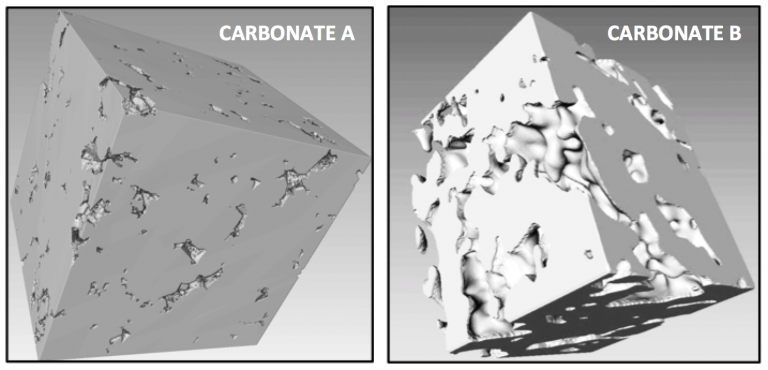The Digital Rock Physics CIPR team has introduced a new concept of subsampling a small digital volume and rearranging the ensuing subvolumes in a large set of new permeability volumes in order to compute the effective absolute permeability of these composites. This simple approach allowed us to obtain physically plausible permeability-porosity transforms relevant to the lithology under examination. Such transforms largely extend a single data pair, a traditional and common product of digital rock physics. The methodology is a combination of the lattice-Boltzmann method (LBM) and Darcy’s flow simulation applied to the randomly generated composites. In doing so, we utilized the concept of process-based averaging and upscaling, a powerful approach that can not only be used with regard to the hydraulic properties of natural rocks, but also their elastic and electrical attributes.
Specifically, by combining micro-CT scans with LBM permeability computations and Darcy’s flow simulations, we have shown that in clastic samples with relatively small permeability heterogeneity, disparate elemental permeability sets obtained, for example, from drill cuttings can be used to estimate the effective permeability of a large host volume of natural rock, as well as produce physically valid permeability-porosity trends. This is not the case in highly heterogeneous samples, such as carbonates, where the effective permeability may be underestimated by an order of magnitude. Still, even in this case, this discrepancy is much smaller than the five orders of magnitude span of elemental permeability values.
Most important, such elemental permeability-porosity sets can also be used to produce a physically meaningful permeability-porosity trend at a scale much coarser than that of the elements, even in highly heterogeneous elemental permeability volumes. We call this new paradigm “to see a trend is a grain of sand.”
The practical significance of these results is that elemental permeability sets obtained using digital rock physics from microscopic rock fragments, such as drill cuttings or sidewall plugs, can be used to estimate the effective permeability of a large block from which they were extracted.

Figure 1. Segmented 3D images of two carbonate samples.

Figure 2. Permeability versus porosity transforms (magenta) produced from microscopic digital images shown in Figure 1. The digitally generated relations are compared to physical laboratory data from relevant carbonate samples. From left to right: Carbonate A; Carbonate B; and both samples together.
The CIPR team was headed by Dr. Jack Dvorkin and included Dr. Jun Li and Mr. Rizwan Hussaini.
References:
- Li, J., Hussaini, S.R., and Dvorkin, J., 2020, Permeability-Porosity Relations from Single Image of Natural Rock: Subsampling Approach, Journal of Petroleum Science and Engineering, 194, Article 107541, 1-11.
